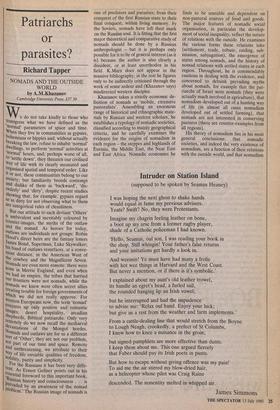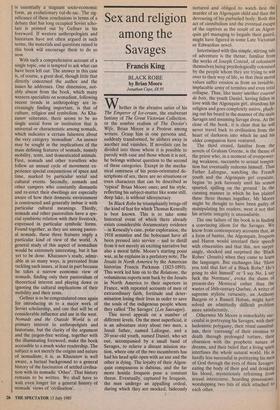Patriarchs or parasites?
Richard Tapper
NOMADS AND THE OUTSIDE WORLD by A.M.Khazanov
Cambridge University Press, £37.50
e do not take kindly to those who W transgress what we have defined as the normal' parameters of space and time. When they live in communities as gypsies, bohemians or hippies and, without actually breaking the law, refuse to inhabit 'normal' !dwellings, to perform 'normal' activities at normal' hours, and, perhaps worst of all, to 'settle down', they threaten our civilised way of life with its clearly measured and Organised spatial and temporal order. Like it or not, these communities belong to our society; but familiarity breeds contempt and dislike of them as 'backward', 'dis- orderly' and 'dirty', despite recent studies Showing that, for example, gypsies regard 14-S. as dirty for not observing what to them are categorical rules of cleanliness.
. But our attitude to such deviant 'Others' Is ambivalent and inevitably coloured by counter-images, the myths of the outlaw and the nomad. As heroes for today, outlaws are individuals not groups: Robin Hood's direct heirs are the fantasy loners tames Bond, Superman, Luke Skywalker; a.s band of outlaws resurfaces, at a conve- nient distance, in the American West of he cowboy and the Magnificent Seven. Nomads are even more remote: there were none in Mertie England, and even when We had an empire, the tribes that harried our frontiers were not nomads, while the II, emads we knew were often secret allies creating trouble for foreign governments of Which we did not really approve. For western Europeans now, the term 'nomad' co, njures up only positive and romantic Images: desert hospitality, arcadian shepherds, Biblical patriarchs. Only very remotely do we now recall the mediaeval devastations of the Mongol hordes. Nomads and outlaws are for us a different sort of 'Other'; they are not our problem, net part of our time and space. Remote and unthreatening, we attribute to their way. of life enviable qualities of freedom, nobility, purity and simplicity. Por the Russians it has been very diffe- rent. As Ernest Gellner points out in his !ssential foreword to this important book, Russian history and consciousness . . . is Pervaded by an awareness of the nomad Problem. The Russian image of nomads is one of predators and parasites; from their conquest of the first Russian state to their final conquest, within living memory, by the Soviets, nomads have left their mark on the Russian soul. It is fitting that the first major theoretical and comparative study of nomads should be done by a Russian anthropologist — but it is perhaps only possible for it to be of general interest (as it is) because the author is also clearly a dissident, or at least unorthodox in his field. K.Marx does not appear in the massive bibliography; in the text he figures only to be indirectly criticised through the work of some ardent and (IChazanov says) misdirected western disciples.
khazanov takes a strictly economic de- finition of nomads as 'mobile, extensive pastoralists'. Assembling an enormous range of historical and ethnographic mate- rials by Russian and western scholars, he establishes a typology of nomadic societies, classified according to mainly geographical criteria, and he carefully examines the evidence for the origins of nomadism in each region — the steppes and highlands of Eurasia, the Middle East, the Near East and East Africa. Nomadic economies he finds to be unstable and dependent on non-pastoral sources of food and goods. The major features of nomadic social organisation, in particular the develop- ment of social inequality, reflect the nature of relations with the outside. He examines the various forms these relations take (settlement, trade, tribute, raiding, sub- mission, subjugation), the emergence of states among nomads, and the history of nomad relations with settled states in each region. Throughout, he is commendably cautious in dealing with the evidence, and concerned to debunk prevailing myths about nomads, for example that the pat- riarchs of Israel were nomads (they were actually much involved in agriculture), that nomadism developed out of a hunting way of life (in almost all cases nomadism developed out of settled farming), that nomads are not interested in conserving pastures (there are counter-examples from all regions).
His theory of nomadism lies in his most general conclusions: that nomadic societies, and indeed the very existence of nomadism, are a function of their relations with the outside world, and that nomadism is essentially a stagnant socio-economic form, an evolutionary cul-de-sac. The sig- nificance of these conclusions in terms of a debate that has long occupied Soviet scho- lars is pointed out by Gellner in his foreword. If western anthropologists and historians have not often argued in such terms, the materials and questions raised in this book will encourage them to do so now.
With such a comprehensive account of a single topic, one is tempted to ask what can have been left out. The answer in this case is, of course, a great deal, though little that directly concerned the author and the issues he addresses. One dimension, not- ably absent from the book, which many western specialists on nomadism, following recent trends in anthropology are in- creasingly finding important, is that of culture, religion and symbolism. As Kha- zanov reiterates, there seems to be no single social form or institution that is universal or characteristic among nomads, which indicates a certain falseness about the very category 'nomadism'. An answer may be sought in the implications of the main defining features of nomads, namely mobility, tents, and domesticated animals. First, nomads and other travellers who follow an annual cycle of movement ex- perience special conjunctions of space and time, marked by particular social and cultural events. Secondly, nomads and other campers who constantly dismantle and re-erect their dwellings are especially aware of how their domestic environment is constructed and generally imbue it with particular cultural meanings. Thirdly, nomads and other pastoralists have a spe- cial symbiotic relation with their livestock, expressed in particular symbolic forms. Found together, as they are among pastor- al nomads, these three features imply a particular kind of view of the world. A general study of this aspect of nomadism would be extremely interesting, but it has yet to be done. Khazanov's study, admir- able in so many ways, is prevented from tackling such issues, at least in part because, he takes a narrow economic view of nomads, finding only their pastoralism of theoretical interest and playing down or ignoring the cultural implications of their mobility and their tents.
Gellner is to be congratulated once again for introducing us to a major work of Soviet scholarship, and one that will be of considerable influence and use in the west.
Nomads and the Outside World is of primary interest to anthropolgists and
historians, but the clarity of the argument and the jargon-free writing, together with the illuminating foreword, make the book accessible to a much wider readership. The subject is not merely the origins and nature of nomadism; it is, as Khazanov is well aware, a factual background to a general history of the fascination of settled civilisa- tion with its nomadic 'Other'. That history remains to be written. We shall have to wait even longer for a general history of nomads' views of 'civilisation'.











































 Previous page
Previous page